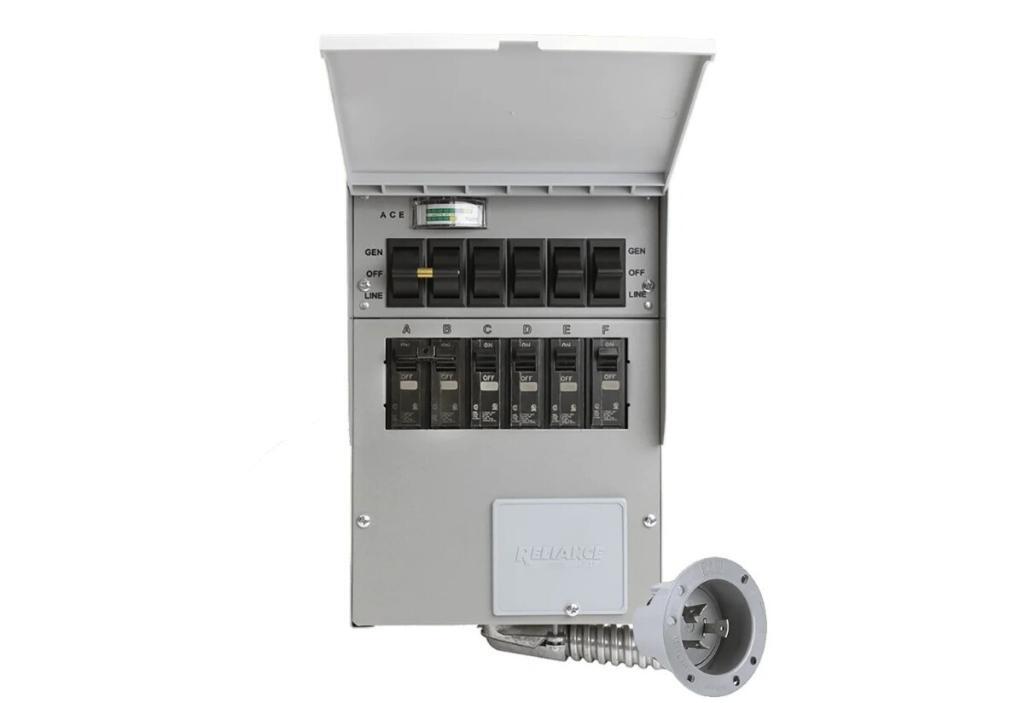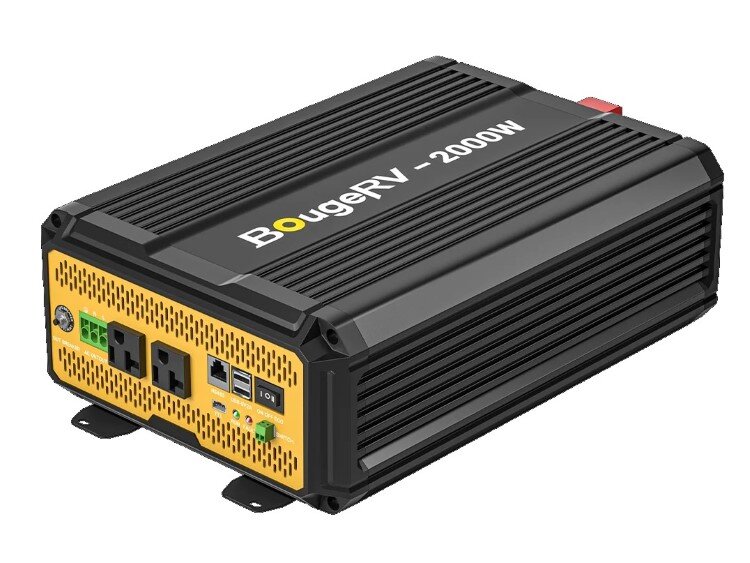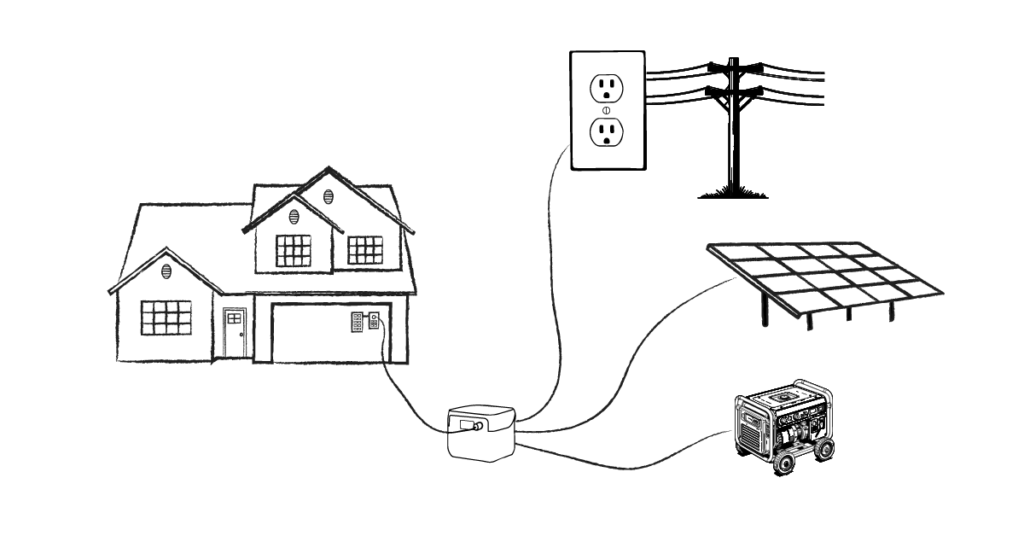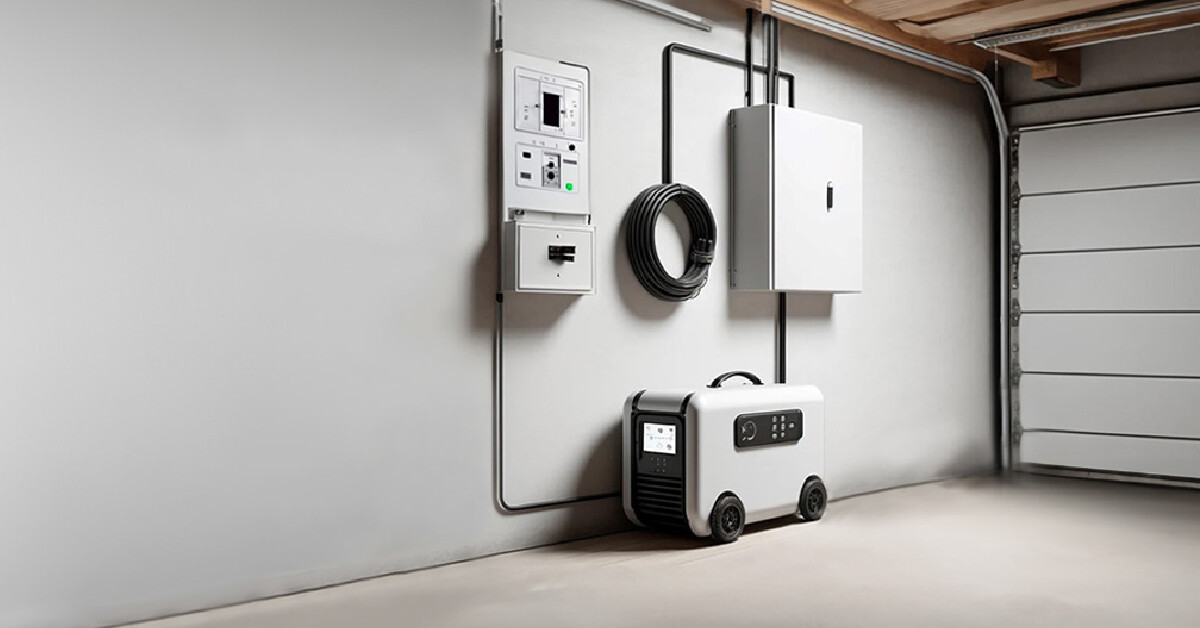Home electricity isn’t just a nice thing to have, it’s an integral part of life. It stops your food from rotting, provides your lifelines to the world, and powers most of your appliances, lights, and devices. A battery backup system for home allows your life to continue, even if the power grid fails.
A home battery bank:
- Ensures safety during emergencies
- Avoids freezers full of wasted food and money
- Lets you move forward with work, play, and everything in between
Some electrical engineers will tell you this is a monumental task. But I’m here to uncover the world of home battery backups in a way you can understand and implement.
With today’s technology, you only really need two devices (transfer switch and solar generator) and a quick installation. These two items can provide the confidence of a complete whole house backup system. You can add solar panels to make a solar powered backup system, but you don’t have to.
Let’s get started so you can see how to get a battery backup system for your home.
We carefully select the products and services we link to. If you buy through our links, we may earn a commission. There’s no extra cost to you and it helps us provide this information.

Basics: Battery Backup System for Home
To create the best battery backup for your house, you’ll need to understand the major parts and how they work together. This brief introduction provides a better view of the situation.
Let’s start with some electricity basics.
Understanding the Flow of Electricity
Think of electricity as something that flows, just like water. Utility companies create a massive electrical flow, then send it out to paying customers through an extensive grid.
This is essentially a network of torrential electricity rivers. These rivers rush by your house, where your devices siphon off what you need.
During a power outage, the torrential river of energy disappears. Your siphon immediately runs dry. The fridge cuts out, your WiFi stops working, and your rooms fill with darkness. You’ve entered an electricity desert where nothing flows.
Having a home battery backup system is like creating a reservoir. One where you can store the electrical flow just as you would store water. When the grid fails, your circuits still have a source to pull from.
There are two main ways you can fill up your reservoir (charge your batteries):
- Use the grid: Fill up your reservoir battery bank quickly by tapping into grid electricity (when it’s available)
- Use solar panels and other energy sources: Fill up your battery backup with your own energy production, providing energy without the grid
When done properly, a grid outage doesn’t disrupt your day. Your breaker has a new source of electrical flow from the battery backup reservoir. It senses when the grid river is dry and seamlessly shifts its source over to the backup reservoir.
You can replenish the reservoir with off-grid sources as needed. Or if you have enough battery storage, you can just fill up when the grid is running and not worry about off-grid charging.
Sounds nice, doesn’t it? Now let’s discuss how it actually happens. This is the basis you need to understand a home backup system.

Essential Parts: Battery Backup System
By installing a home battery bank and backup power source, you create a reservoir of electricity to use during blackouts. I wish it was as simple as digging a hole or building a dam, but it is more complicated.
Here are the essential components to a battery backup system for home:
- Transfer switch: Adds another source of electricity to your breaker box that you can switch over to
- Inverter: Changes the electricity held in batteries (DC) into the form your house uses (AC)
- Battery pack: Where the energy is stored for later use
- Chargers and energy sources: Pulls electricity in from other sources to fill the battery bank
We will go over these four components in detail in the rest of this article.
Creating this entire system from scratch is possible. But it can be much more complicated (and dangerous) than most people want to bite off. And having one custom built by professionals is extremely expensive, time-consuming, and prone to needing repair.
Thanks to innovative technology and incredible companies, there is a shortcut.
A solar generator includes a battery bank, an inverter, and multiple charging systems in one device. Also known as a portable power station, this amazing piece of equipment provides a plug-and-play backup battery for your house. You plug the solar generator into your transfer switch and that’s it.
Let’s dive a little deeper into the pool of electricity to see what these parts are all about.

Transfer Switch: Adding a Second Energy Source
You can’t just add a battery to your breaker box directly. The first piece of magic is the transfer switch.
The transfer switch connects electricity from your backup battery source to your home electrical circuits. It lets you switches between incoming electricity sources.
With a transfer switch, the breaker box can choose from the torrential river off the grid or the battery backup reservoir.
An added benefit is that you can use the switch to use your backup system to avoid peak energy costs. Switch over to it during peak hours and you’ll skip the overpriced energy. Then you can charge your backup system during low-priced hours.
A transfer switch can be manual or automatic:
- Manual transfer switches: Require your input to change energy inputs, usually through a physical switch on the device
- Automatic transfer switches: Detect outages and automatically change sources to keep your circuits powered
You can get battery backup systems that will power your entire home. But it’s much more common to use them for select circuits, avoiding non-essential circuits or ones that require too much energy (such as an electric dryer or air conditioner).
Transfer switches usually connect to a critical loads panel. This is where you select which circuits to power from your backup source. It includes things like your refrigerator, medical devices, and a select set of lights or outlets.
Many companies integrate the switch and critical loads panel into one device.
Since this requires some modifications to your existing breaker box, installing a transfer switch is one of the most complicated parts of creating a house backup battery system. This is one step that professional installation can be necessary.
But you don’t have to turn over the whole job to them. When you select the right solar generator and transfer switch, you literally just plug in the rest of the equipment with one cord. You can even use solar panels without over-priced installations. Keep reading to see how.

Inverter & Connectors: From Battery to House
Even with a transfer switch, you still can’t wire a battery directly to a house. The energy stored in batteries is in DC (direct current) charge while houses use AC (alternating current). To get from DC to AC, a power inverter is used.
You could say that the house uses electricity that flows like water, while the battery has electricity that flows like oil. The two just don’t mix.
The power inverter is the miracle of change, switching the battery’s DC into the AC that works in the house. This crucial element is one of the most expensive parts of a home battery backup power supply.
Connecting the inverter to the transfer switch involves a wire with a lot of electricity flowing through it. The more capable your power inverter, the more things you can power. And the larger the wire is.
High-quality home backup solar generators can tackle this job without a hassle. They have built-in inverters with high-capacity outlets. You simply plug the a high-amp cable into the solar generator on one side and the transfer switch on the other. That’s it. It’s just like an RV hookup at a campground. They can also have 240V outlets.
And don’t be fooled by the name. Solar generator here is mainly a large battery pack with an inverter and a variety of chargers built in. They can use solar panels, but can also be charged by a variety of other sources, including the grid and fuel generators. An added benefit is that they can also function as a uninterruptible power supply, keeping your essential devices powered on even through grid outages.

Battery Storage: The Anchor to Home Backup Power
Next up is the backup battery bank. The heart of the beast. That battery bank is the reservoir of electricity to use when the grid cuts out.
The size of the battery bank is one of the most critical elements to this entire system. It’s also one of the most expensive, greatly increasing as your electrical demands go up.
To power your entire house, including appliances like dryers, air conditioners, and induction stovetops, you are looking at a serious investment. A very large battery backup system like this can easily run $10,000 or more.
For some people, the confidence of a giant home backup battery bank is money well spent. The Tesla Powerwall is a great example that fits into this category. This is usually accompanied by a rooftop solar array.
But there’s great news. You don’t have to go this route.
Instead, portable solar generators offer a more flexible and affordable way to buy your home backup battery bank. The initial purchase price can vary greatly and meet your budget no matter where it is. $5,000 will provide a very capable system, but even just $1,000 will keep your lights on and your fridge running for hours. It could pay for itself in one power outage.
And the best solar generator brands offer external battery packs. Your battery pack can easily grow over time.
Start small and purchase one solar generator with panels to start with. If done correctly, it can cover many devices and outlets, including things like a refrigerator, computers, and lights. Then buy external battery packs as you need them.
For more details about the right batteries, read our article on Which Solar Battery Is Best? Lead-Acid vs. Lithium.
But there’s another way to get around an endless need for more battery capacity. Charging.

Charging: Filling the Electrical Reservoir
There’s nothing wrong with using the grid to charge your battery backup. It’s easy and avoids extra costs. The downside is that you must have a large battery to get through any outage. And if the outage is too long, you may run out of battery.
To be prepared for longer power outages, add a secondary off-grid electrical source. This helps to:
- Recharge your battery while the grid is down
- Use a smaller battery bank since you have energy flowing in
- Reduce your energy bills by creating your own electricity
Adding another energy source balances the costs of your system while also increasing its capabilities. Off-grid charging makes your entire backup system much more useful.
You can add electrical juice back to the reservoir from off-grid sources such as:
- Portable solar panels deployed when needed
- Fixed solar panels mounted on your roof or in your yard
- Propane, gasoline, or diesel fuel generators
- Other off-grid sources like windmills and water turbine generators
For more details on creating your own off-grid power, read our article on How to Generate Your Own Electricity.
Thankfully, this is another area where solar generators make things easy. The best ones have multiple charging methods built-in to the design. Literally plug in solar panels, generator, or grid outlet to fill the battery.
To do this without a solar generator, you need to get an appropriate charger for every input going to your battery. This usually includes at least one input for grid charging on an AC outlet and another charger for solar systems. You may want to add other DC chargers. It can be quite complicated.
Once you identify the chargers you need, then you’ll need to wire them with appropriate gauge wire and terminals. A good charging and battery management system is also needed so your system uses the multiple inputs efficiently.
The solar generators take all this weight off your shoulders with perfectly engineered systems tucked neatly in one small box. All the chargers you could need, perfectly designed to match the battery and inverter.

Whole House Solar Generator Backup Systems
And with that information, you now know the basics of a home battery backup power system.
Once you install a transfer switch, you just plug in a solar generator and you’re ready to go. Really! It is that simple.
Add solar panels for off-grid charging. Throw in a fuel generator if you want extra confidence. Buy external battery banks to increase your capacity over time. But there are all nice additions, not necessary to start with.
The only thing to figure out is what solar generator you want to get. Head over to our post on the Best Solar Generators for Home Backup to find the right one for your needs.
On the other hand, if you want to build your own backup battery system for your home, that is possible. You’ll either have to hire professionals or know how to:
- Select the right batteries, inverters, and chargers
- Wire the inverter to the battery with appropriate gauge wires
- Install safety fuses and necessary cutoff switches
- Connect solar panels to a charger, then to the battery
- Add a shore power charger for an outlet connection
- Implement a way to monitor the system
Or you just get the transfer switch installed and plug in a solar generator with some panels attached. Done and done.

How Long Will a House Battery Backup Last?
Figuring out how long a battery backup system will last is a calculation with a lot of moving parts.
You need to know:
- An idea of the devices you want to use and how much energy they need
- The size of the battery you will have that serves as the energy reservoir
- How quickly you can recharge the battery while the grid is down
Let’s go over some basic examples.
How Long a Small Solar Generator Lasts
If you only want to power a few essential items in your house, like charging phones and having some lights, your electrical needs will be relatively small. Let’s call it a constant draw of 100 watts (W), which is like a small trickle of water.
Note: These calculations are simplified to make things easy. In reality, batteries always provide less than the rated energy stored. Things like wires used, inverter efficiency, and other factors determine how close to actual ratings you’ll get.
An entry-level home backup solar generator has about 1,000Wh (1kWh) battery capacity. You can run these devices for 10 hours. That’s like a cup of water that you’re barely sipping out of the entire time. Not bad.
If you add a small solar panel to this setup (~200W), you can pretty easily create a never-ending stream of electricity for these small devices. It will replenish the electricity faster than you use it during the day, then the battery can take over at night.
How Long a Large Solar Generator Lasts
On the other hand, if you run a refrigerator, induction stovetop, and other high-powered devices, your electrical draw can jump up to 2,000W, likely even more. This is like opening multiple large faucets. The electrical flow is much more substantial.
That same 1,000Wh battery bank will last less than 30 minutes. Which is better than nothing, but far from ideal.
You can still create a battery backup. But your battery will need to be bigger and you will want to get a way to recharge when the grid is down.
For this situation, you want to get a bigger solar generator battery bank, perhaps something closer to 10,000Wh (10kWh). And you should get serious about charging. You can add more solar panels (500W or more) or have a fuel generator around. That will actually get you through some power outages.
If you’re wondering why you’d get a fuel generator, it’s because they’re cheap and will provide a lot of power to your battery pack. You can run the fuel generator for a small time, say 30 minutes to an hour, to get a lot of energy stored in your battery. Once charged up, turn off the combustion engine on the fuel generator and let your solar generator (battery backup) take over.
How long a solar generator lasts comes down to how much electricity you need, the size of the home battery bank, and the recharging methods you choose.

How Much Does a Solar Powered Home Backup System Cost?
Let’s talk about cold hard cash. You might be thinking that since rooftop solar panels usually have a high cost, a solar powered backup system must be even worse.
Thankfully, that’s not the case. Using a solar generator to create a home backup power source can be amazingly affordable.
The transfer switch and critical loads panel is one major purchase. With installation, estimates typically range from about $500 all the way up to about $3,000 or more for more powerful units and installation in expensive areas.
The only other thing you need is a solar generator.
Some of the best brands of solar generators have 1,000Wh battery banks with 200W solar panels for less than $1,000. You can get kits with large solar panels (~450W) and a ~2,000Wh battery bank for around $2,000 to $3,000. An extra 2kWh battery pack can be about $1,000.
This means some of the cheapest solar powered home backup systems cost less than $1,500. Or you can get a fairly robust system for less than $5,000.
That’s an incredible price for energy independence and confidence.
If you want to get more serious about your system, you can increase your budget accordingly. To get a very large battery, inverter, and solar panel array, you might need to spend closer to $10,000. Many systems allow you to grow over time, so this doesn’t have to be a one-time expense. But at this level, you’ll to create an amazing battery backup system for home where you never have to worry about electrical outages again.
Many solar powered battery backup systems also qualify for tax incentives. You may get up to 30% back as a federal tax credit. Some states waive sales tax and offer additional tax benefits.

Wrap Up
Creating a whole house backup battery power system has never been easier. A solar generator has the chargers, battery, and inverter you need. Install a transfer switch to your existing breaker box, then plug in your new solar generator and you will never have to worry about power outages again.
You can also create your own backup battery power system. You’ll need the right batteries and an AC power inverter at minimum. But you also want to figure out a charging system, a monitoring system, and all of the fuses, wires, and cutoffs.
Let’s keep this progress going by checking out the best solar generators for home battery backup.







